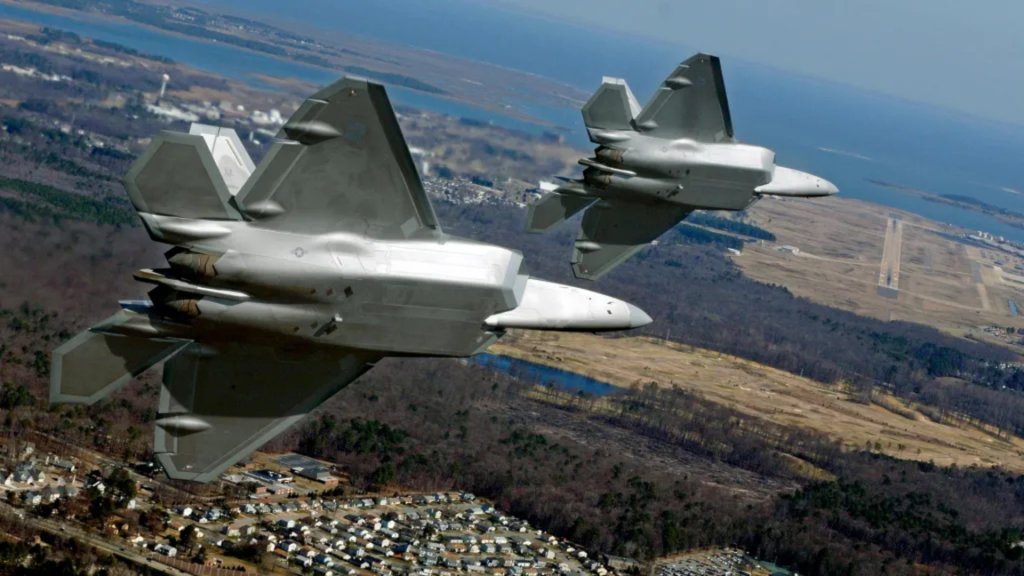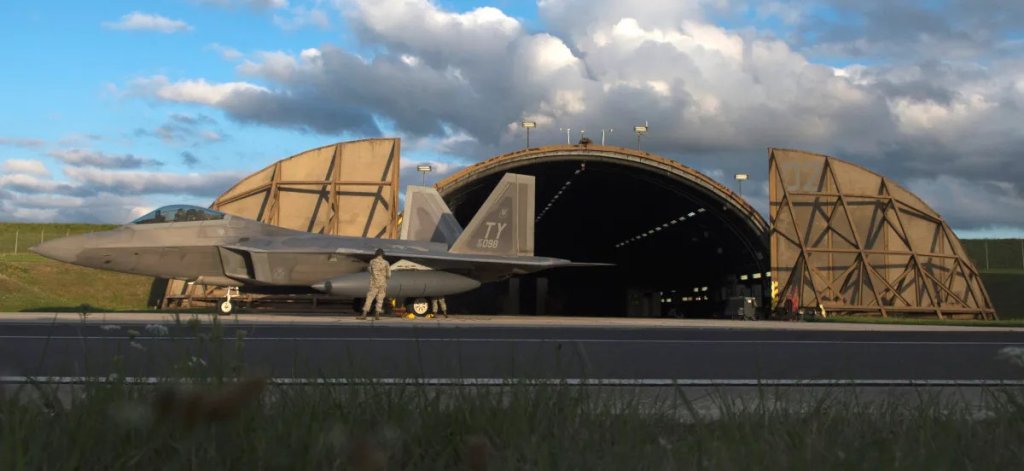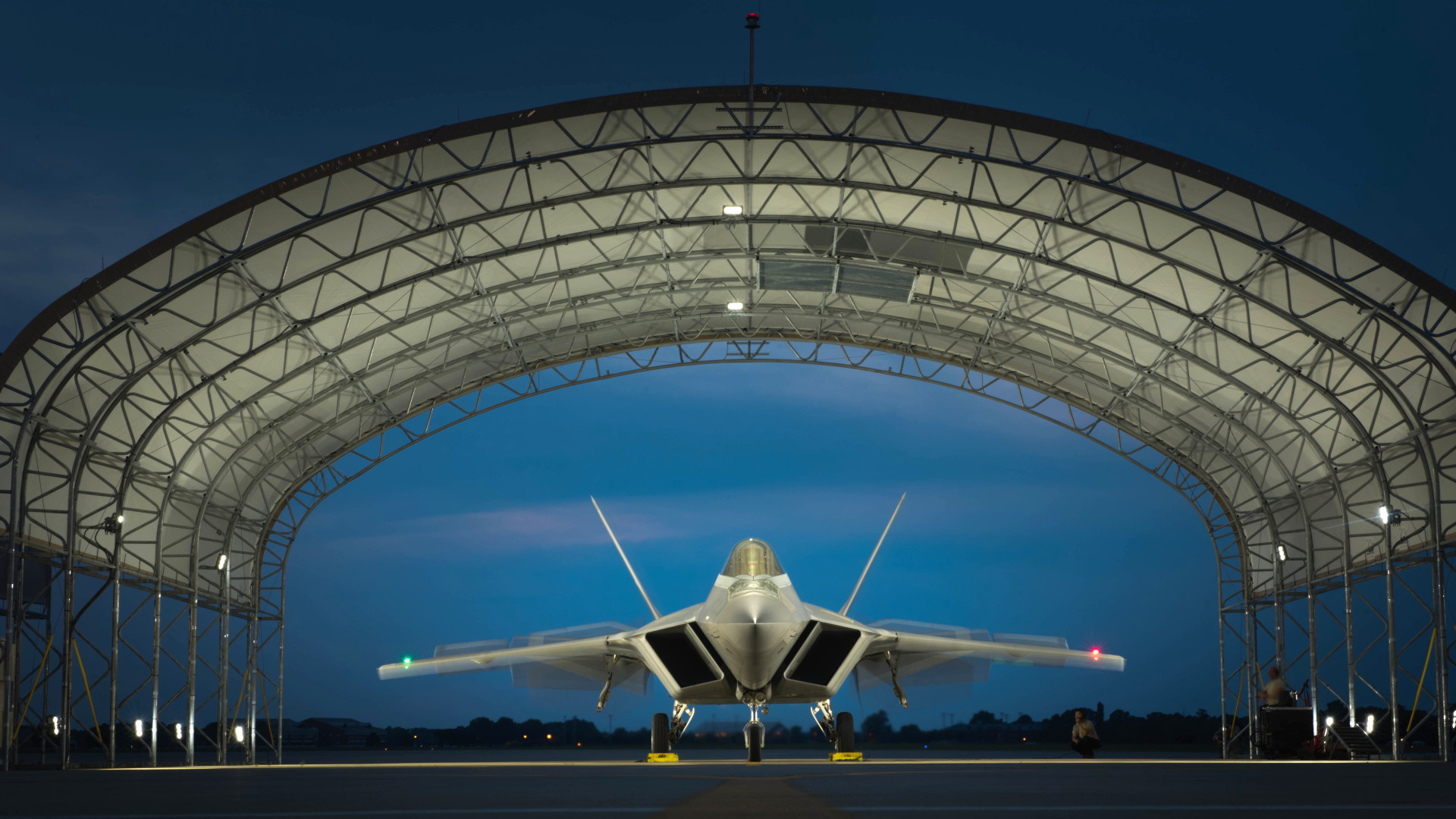U.S. Air Force officials at Langley Air Force Base in Virginia are looking at installing anti-drone nets to help protect F-22 Raptor stealth fighters on the flightline. This comes nearly a year after the base was subjected to waves of still-mysterious drone incursions, which The War Zone was first to report. It also underscores the U.S. military’s continued lag when it comes to responding to the very real threats posed by uncrewed aerial systems, at home and aboard, and particular hurdles to doing so domestically.
Langley’s 633rd Contracting Squadron put out a notice on October 4 asking for information about potential counter-drone netting that could be installed around up to 42 existing open-ended sunshade-type shelters at the base. Langley, now technically part of Joint Base Langley-Eustis, is one of a select few bases to host F-22s and is a key component of the Air Force’s posture to defend the U.S. homeland.

The 633rd “is in the process of determining the acquisition strategy to obtain non-personal services for the Unmanned Ariel Services (UAS) Netting for East Ramp Metal Sunshades,” according to the contracting notice. “The intention of the netting is to deter and ultimately prevent the intrusion of UAS’s near airmen and aircraft. This initial sunshade netting installation on the metal sunshade (bay Alpha 1) shall serve as a proof of concept for the remaining sunshades.”
The “netting should be capable of disabling a Group 1/ “Small” Unmanned Aerial Systems (UAS), such as the DJI Matrice 300 RTK, while remaining attached,” the notice explains. Per the U.S. military’s definitions, drones in Group 1 can have weights of up to 20 pounds, fly up to 1,200 feet, and reach speeds of up to 100 knots.
The “netting shall be composed of a UV-resistant, moisture-resistant material capable of withstanding temperatures up to 400°F without damage. It shall also have a tensile strength of 200 lbs. or greater. Polyester or nylon are preferred materials, but any material with adequate properties is acceptable. Netting squares shall be no larger than 3” across,” the notice adds. “Additional hardware and cabling should be strong enough to support the net and potential push or pull due to 40 mph winds when the netting is deployed and 120 mph (3-second gust) when netting is retracted/stowed. When retracted/stowed, the netting must be adequately secured. Lead core or other forms of weights installed along the bottom of the netting may be necessary to prevent the netting from blowing into aircraft or personnel; design may include recessed anchoring to existing concrete pad. Alternative means of anchoring the netting may also be acceptable.”
However the nets are configured and installed, the 633rd says they need to be “quickly and easily retractable” so F-22s can get in and out without issue. The installations also can’t impede movement along the adjacent taxiways in any way.

In May, the 4th Contracting Squadron at Seymour Johnson Air Force Base in North Carolina put out a similar call for potential “passive” drone defense options, which could also include nets, to help protect that base’s F-15E Strike Eagle combat jets.
As already noted, the possibility now of adding anti-drone nets to the sunshades at Langley comes after that base experienced a series of still-unexplained drone incursions over the course of several weeks last December. Though the Air Force said at the time that there did not appear to be any “hostile intent” behind those incidents, they still prompted a major whole-of-government response that you can read more about in detail here.
Langely had been subjected to unauthorized drone incursions before then that the Air Force acknowledged had both disrupted operations at the base and highlighted potential threats, as well.
“One day last week I had two small UASs that were interfering with operations… At one base [Langley], the gate guard watched one fly over the top of the gate check, tracked it while it flew over the flight line for a little while, and then flew back out and left,” now-retired Air Force Gen. James “Mike” Holmes, then head of Air Combat Command (ACC), said back in 2017. “Imagine a world where somebody flies a couple hundred of those and flies one down the intake of my F-22s with just a small weapon on it.”
When that news emerged, The War Zone noted that it would be ever easier for a hostile actor to simply target aircraft exposed while parked on the flightline. Doing so would also offer adversaries a means to neutralize large numbers of planes before they could even into the fight.

The War Zone has otherwise been sounding the alarm about threats posed on and off traditional battlefields by drones, including small commercial types like the DJI Matrice 300 RTK mentioned in the 633rd’s contracting notice that can be readily weaponized, for many years now. Worrisome incidents around U.S. bases and other military assets domestically, including ships off the coast of Southern California and aircraft flying in restricted airspace, as well as critical non-military infrastructure within the United States have only continued to emerge in recent years.
Just in August, we were the first to report on a series of mysterious drone incursions around the Air Force’s Plant 42 in Palmdale, California, which ultimately led to the imposition of new temporary flight restrictions around the facility. Plant 42 is a top hub for advanced aerospace development work, including highly classified military programs like the B-21 Raider stealth bomber.

This is a concerning trend that has now also been steadily emerging globally. The ongoing fighting in Ukraine has now fully driven the reality of uncrewed aerial threats, especially when it comes to highly maneuverable first-person view (FPV) kamikaze drones and other smaller weaponized types, into the mainstream discourse. Both Ukrainian and Russian forces have actively been targeting each other’s aircraft on the ground, including with drones and over great distances.
Various tiers of drone capabilities are only continuing to proliferate and a new major technological evolution, if not revolution, spurred on by advances in artificial intelligence, now looks to be on the horizon, as you learn more about this War Zone feature. The bar to entry, particularly when it comes to acquiring and employing FPV-type and other smaller weaponized drones, is already very low.
This all, in turn, has also prompted a new explosion in demand for counter-drone capabilities, including within the U.S. military. It’s interesting to note here that nets were among the first countermeasures to emerge on the battlefield in Ukraine.
Installing nets at Langley certainly represents one option for helping to address threats posed by smaller drones, but also one that would be most useful as part of a larger layered array of active and passive defensive measures. As the 633rd’s contracting notice makes clear, the immediate goal with the nets is only to shield against very localized intrusions by the lowest tier of drones.
The fact that this initial contracting process has only begun now after the December drone incursions and the ones in 2017, which are just the incidents at Langley we know about, is also telling. This comes amid a larger debate inside the U.S. military and out about how best to protect American military bases and other assets domestically, as well as forces in the field, from drones. Members of Congress have been particularly vocal in recent months in their criticism of steps the U.S. military has taken to date, especially when it comes to hardening physical infrastructure against uncrewed aerial systems and other threats, as you can read more about in detail here.

At the same time, the U.S. military also continues to be faced with a morass of often convoluted legal, regulatory, and other challenges when it comes to implementing counter-drone capabilities domestically. The previous contracting notice from Seymour Johnson explicitly highlighted the attractiveness of “passive” defense options since they are not subject to Federal Aviation Administration (FAA) restrictions.
Efforts have been made in the past to try to expand and otherwise streamline authorities available to U.S. military forces to take more active actions against drone threats, but issues clearly remain. These same factors also apply to other branches of the U.S. government. There have been legislative proposals from members of Congress just in the past few months to give new domestic counter-drone authorities to the Department of Homeland Security, Department of Justice, and the Central Intelligence Agency.
The recent anti-drone net contracting notice Langley only further underscores the critical need now to address these issues and otherwise take steps to help defend bases and other key assets against uncrewed aerial threats with an array of capabilities.
Contact the author: joe@twz.com
